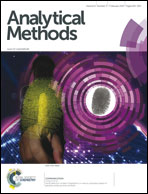Luminescence functionalization of porous silica nanospheres by YVO4:Eu3+ for the efficient recognition of λ-cyhalothrin in aqueous media
Abstract
Porous silica nanospheres were fabricated using a facile surface-protected etching strategy. Polyvinylpyrrolidone (PVP) was used as a protecting polymer adsorbed on the surface of silica nanospheres and NaOH was employed as an etching agent. Owing to the protective action of PVP and inhomogeneous etching, mesopores were created in the silica nanospheres. Then, based on a simple and economical wet-chemical route, highly luminescent YVO4:Eu3+ nanocrystals were then integrated onto the nanospheres to form a highly luminescent mSiO2/YVO4:Eu3+ composite material. This material, which combined the mesoporous structure of SiO2 and the strong red luminescence property of YVO4:Eu3+, could be used as a novel optosensing system. The structure, morphology, porosity, and optical properties of the materials were well characterized by X-ray diffraction, Fourier transform infrared spectroscopy, scanning electron microscopy, transmission electron microscopy, N2 adsorption/desorption, and photoluminescence spectra, and the optical stability and effect of pH on mSiO2/YVO4:Eu3+ were also evaluated. It was observed that λ-cyhalothrin (LC) could quench the luminescence of mSiO2/YVO4:Eu3+ in a concentration-dependent manner, which was best described by a Stern–Volmer-type equation. This study therefore demonstrated that the composite material could be potentially used as a probe to monitor the residues of LC in water.


 Please wait while we load your content...
Please wait while we load your content...